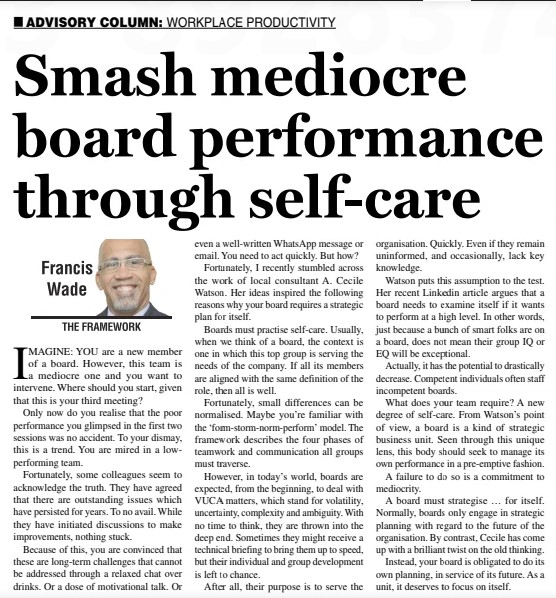Imagine you’ve joined a board, only to discover it’s deeply mediocre. This is your third meeting, and it’s becoming clear that the issues you sensed in the first two weren’t incidental—they’re ongoing. How do you address this underperformance?
Luckily, you aren’t the only one who’s noticed. Some members recognize that long-standing issues have held the board back for years, and while they’ve tried initiating change, nothing has stuck. These are complex, systemic challenges that won’t be resolved by casual discussions, pep talks, or a thoughtful email. Swift, strategic action is needed. But how?
I recently encountered insights from consultant A. Cecile Watson that shed light on why boards need their own strategic approach. Her perspective inspires these key reasons for why your board must implement a self-care plan.
Why Boards Should Prioritize Self-Examination
Boards are often envisioned as serving the organization’s needs. If all members align with this vision, things should function smoothly. Small differences can be ironed out, much like in the “Form-Storm-Norm-Perform” teamwork model, which illustrates the stages groups move through to achieve high performance.
However, boards today face a high-pressure environment, dealing with complex VUCA (Volatile, Uncertain, Complex, and Ambiguous) issues from the outset. While they might receive briefings, individual and group development often gets overlooked in the rush to deliver.
This traditional expectation—that boards serve swiftly, even if under-informed—faces scrutiny in Watson’s latest article. She argues that boards must practice self-reflection and strategy if they’re to excel. Smart people on a board don’t guarantee a high group IQ or EQ; in fact, group performance can suffer if proactive measures aren’t in place.
What does your board need? A new level of self-care. Watson suggests that boards operate as a kind of strategic unit, managing their performance preemptively. Failing to do so only perpetuates mediocrity.
The Case for Board Self-Strategy
Typically, boards focus on “strategic planning” for their organization’s future. Watson’s approach takes this one step further: boards must also strategize for themselves. As a unit, they need the space to address their own evolution.
This doesn’t mean ignoring corporate planning. In fact, I’ve previously recommended that board members actively engage in their organization’s strategic retreats, where they contribute to shaping long-term goals.
Yet, once these retreats end, some boards must adapt as well. For instance, one board I worked with chose to refresh its membership, reducing both the average age and tenure of its members to bring new perspectives aligned with the strategic plan.
In another case, a board had grown complacent. Members showed up sporadically, often unprepared. This lack of accountability permeated the organization, undermining its standards and culture.
Unfortunately, board evaluations alone rarely spark transformation. Instead, Watson advocates for a written Board Strategy, a guiding document that steers the board’s actions.
Creating a Strategy for the Board
Watson advises boards to define a vision for themselves and set measurable milestones to ensure the plan stays on course. While this may sound overwhelming for already busy board members, it’s ultimately about cultivating the right mindset, not rigidly following a checklist.
Adopting these principles can help your board become resilient, better equipped to navigate future challenges, and able to avoid the slow slide into mediocrity that affects many corporate teams.
Enjoying this short post? Consider joining the JumpLeap Long-Term Strategy and Podcast, full of long-form content on game-changing strategic planning.
This post was based on an article published in the Jamaica Gleaner.

